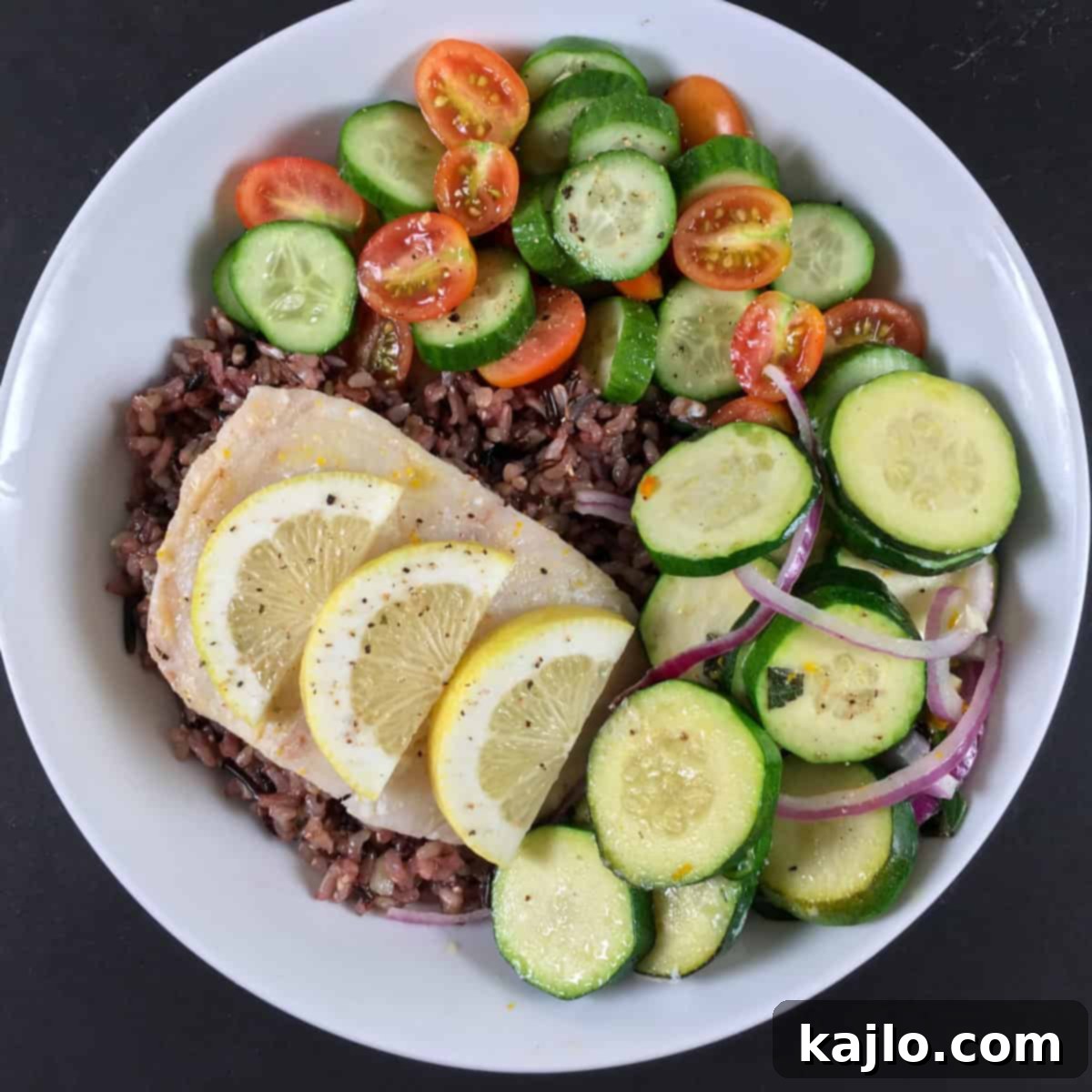Experience Culinary Excellence: Mastering Cod En Papillote with Lemon-Butter Sauce
Imagine a dish where delicate fish, vibrant vegetables, and a rich, aromatic sauce all cook together in a sealed packet, emerging perfectly moist, tender, and bursting with flavor. This isn’t a chef’s secret from a Michelin-starred restaurant; it’s the magic of Cod En Papillote – a remarkably simple yet elegant cooking method that promises consistently delicious results. “En papillote” literally means “in parchment,” referring to the technique of baking food within a sealed parchment paper or foil packet. This method locks in moisture and infuses every bite with the carefully selected seasonings, ensuring your fish is succulent and never dry. Prepare to elevate your weeknight dinners and impress guests with this incredible recipe for cod in parchment with vegetables and a delectable lemon-butter sauce. It’s a culinary revelation you simply must try!
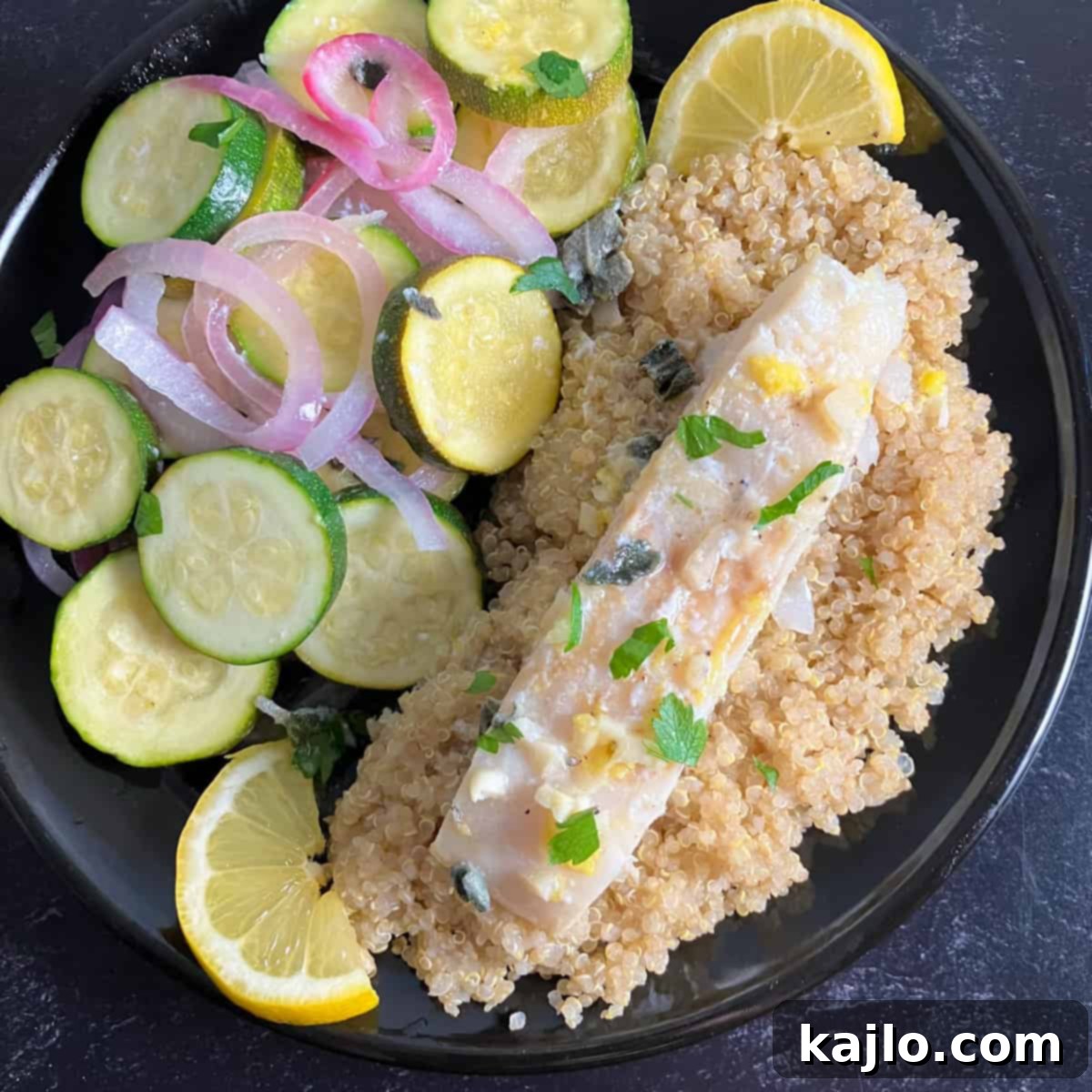
The Art of En Papillote: Unlocking Flavor and Moisture
The “en papillote” cooking method is a time-honored technique cherished for its ability to create exceptionally moist and flavorful dishes, particularly with delicate proteins like fish. By sealing ingredients in a parchment paper (or foil) packet, you create a mini-steam oven in your regular kitchen oven. This gentle, moist-heat cooking environment prevents the food from drying out, which is a common challenge when baking or pan-frying fish. Instead, the fish steams in its own juices and the added liquid (like our lemon-butter sauce), becoming incredibly tender and flaky. This method isn’t just about perfect texture; it’s also a fantastic way to infuse robust flavors, as all the aromatic elements are trapped within the packet, concentrating their essence into the food.
While I’ve previously explored other steaming methods, such as steaming fish in banana leaves, I understand that exotic ingredients can sometimes be hard to source. That’s why I’m thrilled to share this alternative using readily available ingredients like parchment paper and foil, bringing a delightful Mediterranean flair to your table. The beauty of cod in parchment paper packets lies in its accessibility and versatility. Unlike banana leaves, parchment paper is flavor-neutral, meaning it won’t impart any additional taste to your fish. This gives you complete control over the flavor profile, allowing you to use a wider range of seasonings and herbs to achieve your desired culinary masterpiece. With this method, the possibilities for customization are endless!
For this particular recipe, we’re crafting a luxurious lemon-butter sauce, enriched with the pungent notes of garlic, the subtle sweetness of red onion, and the earthy aroma of fresh sage. As the cod bakes and steams within its tightly sealed packet, the butter melts, mingling with the zesty lemon juice to create a rich, flavorful broth. This liquid constantly bathes the fish and vegetables, ensuring everything remains incredibly moist and tender while absorbing all the exquisite flavors. The result is a sensory delight – an effortlessly elegant dish that tastes far more complex than it is to prepare. Don’t just take my word for it; experience the magic yourself!
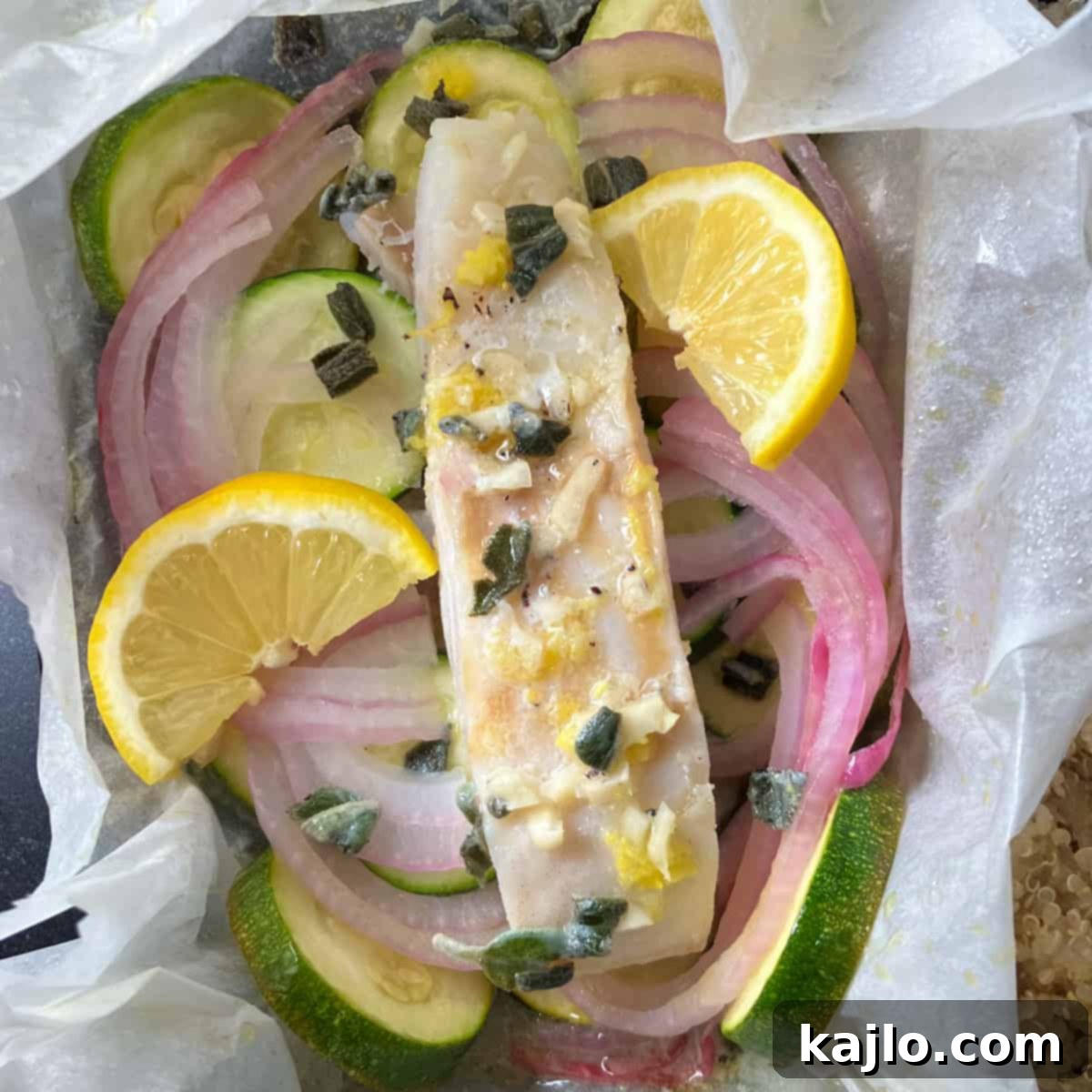
Fresh Ingredients for Exquisite Cod En Papillote
Gathering high-quality ingredients is the first step to creating a truly memorable baked cod en papillote with vegetables. Here’s a detailed look at what you’ll need to make this vibrant and healthy dish, along with tips for selection:
- Boneless Cod Fillets: Opt for fresh, firm cod fillets, ideally about ¾-inch (1.9 cm) thick. Cod is a lean, flaky white fish that holds up beautifully to steaming, absorbing flavors readily. If using frozen cod, ensure it is fully thawed and patted dry before use to prevent excess moisture in the packet.
- Cooking Oil Spray: A light mist of cooking spray on the parchment prevents sticking and helps the vegetables cook gently.
- Sliced Zucchini: Fresh zucchini, cut into ½-inch (1.27 cm) thick slices, provides a tender, slightly sweet counterpoint to the fish. It cooks quickly within the packet, making it an ideal companion.
- Freshly Squeezed Lemon Juice: The cornerstone of our bright lemon-butter sauce. Always choose fresh lemons for their superior, zesty flavor compared to bottled juice.
- Lemon Zest: The zest contains aromatic oils that intensify the lemon flavor, adding a fragrant brightness that permeates the entire dish.
- Crushed Garlic Cloves: Fresh garlic offers a pungent, savory base for the sauce. Crush them just before use for maximum flavor release.
- Salt and Pepper: Essential seasonings to enhance all the natural flavors. Adjust to your personal taste.
- Thinly Sliced Red Onion (or Shallot): Red onion adds a mild, piquant sweetness and a beautiful color. Shallots can be used for a slightly milder, more refined flavor.
- Fresh Sage Leaves: Sage provides a distinctive, earthy, and slightly peppery aroma that pairs wonderfully with cod and lemon. Other fresh herbs like parsley, thyme, chives, dill, rosemary, or marjoram can also be used, offering different flavor profiles. Experiment to find your favorite!
- Butter (or Olive Oil): Butter melts into a luxurious sauce within the packet, adding richness and helping to carry the flavors. For a dairy-free alternative or a lighter touch, high-quality olive oil works beautifully.
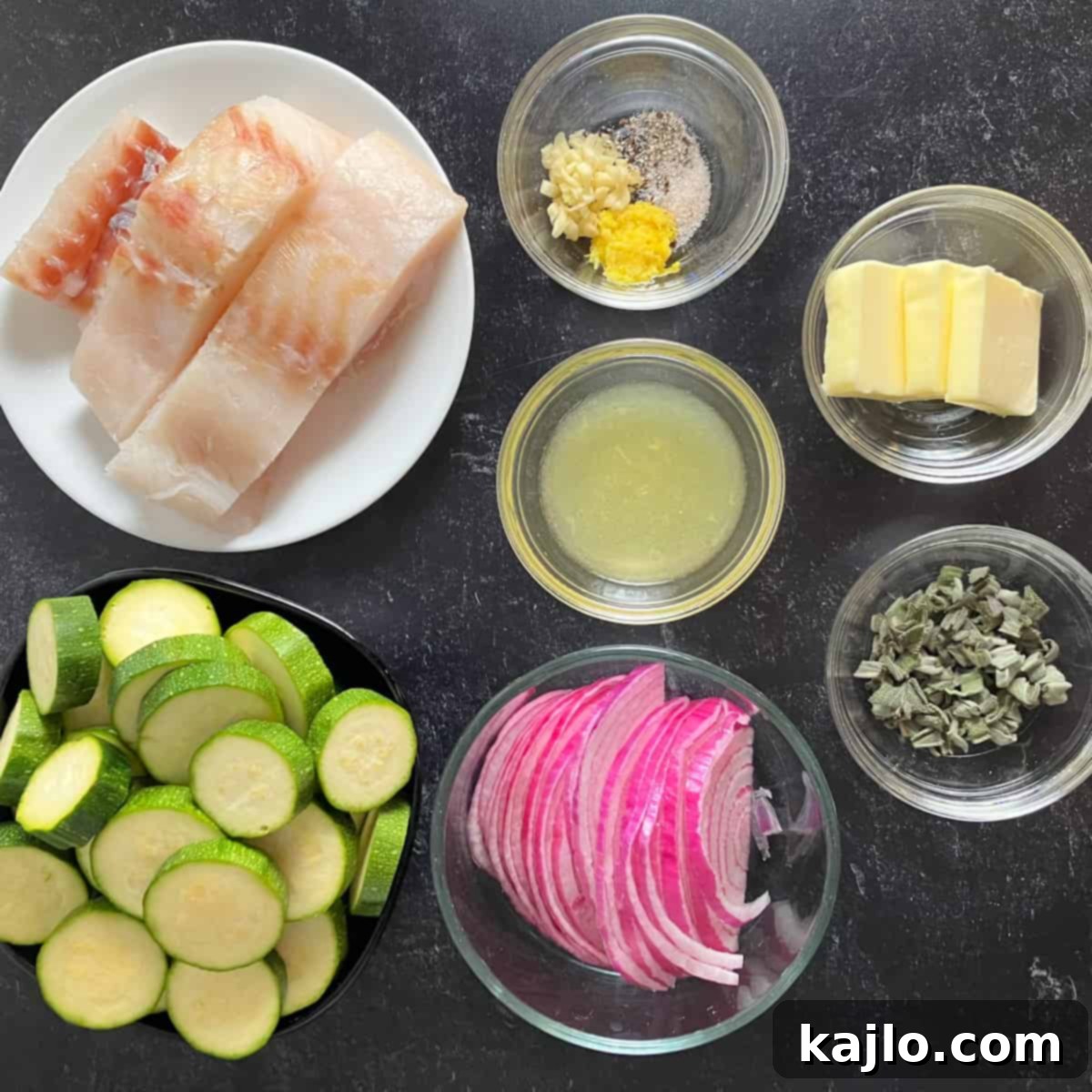
For precise measurements and quantities of these ingredients, please refer to the detailed recipe card further down this page.
Step-by-Step Guide: Crafting Your Perfect Cod En Papillote Packets
Cooking en papillote might sound fancy, but it’s surprisingly straightforward. The key lies in assembling and sealing your packets correctly to ensure a flavorful, moist result. Follow these detailed steps to master how to cook en papillote and create a restaurant-quality meal right in your own kitchen.
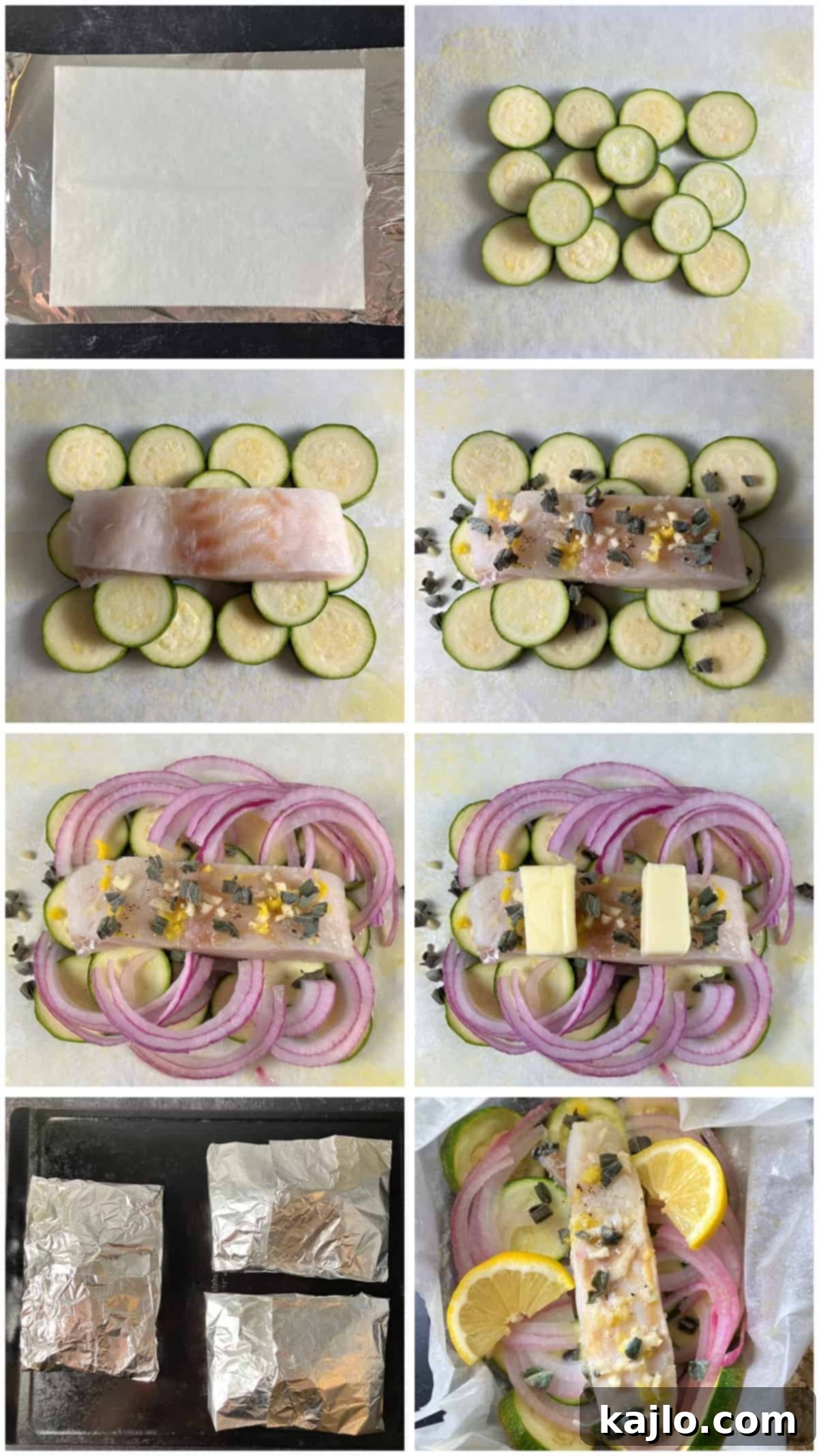
Prepare Your Parchment and Foil Layers
For each cod packet you intend to make, you will need two layers: one sheet of parchment paper placed directly on top of one sheet of aluminum foil. While I often estimate, aim for sheets approximately 14-18 inches (35-45 cm) long. It’s always better to err on the side of generosity; having too much parchment and foil is preferable to too little. This ensures you have ample material to fully enclose your ingredients. An improperly sealed packet will allow steam and precious flavorful sauce to escape, leading to dry fish and a messy oven cleanup – something we all want to avoid!
Layer the Zucchini
Lightly mist the center of each parchment paper sheet with your chosen cooking spray. This subtle layer helps prevent any delicate parts of the fish or vegetables from sticking. Next, arrange your zucchini slices on top of the misted parchment. I typically create a neat rectangular bed, about 3 slices by 4 slices, for each packet. If you have any remaining zucchini, simply layer it on top of the rectangle. The zucchini acts as a supportive and flavorful base for the cod, ensuring even cooking and moisture distribution.
Assemble the Cod and Flavorings
Carefully place one cod fillet directly on top of the zucchini bed in each packet. Now, it’s time to build the flavor! Drizzle the fresh lemon juice generously over the cod, followed by a sprinkle of vibrant lemon zest, minced garlic, salt, and pepper. These foundational seasonings will permeate the fish as it cooks. Next, distribute the finely chopped fresh sage leaves and the very thinly sliced red onion over the cod. The sage provides an earthy counterpoint, while the red onion adds a delicate sweetness and a hint of sharpness. Finally, crown each packet with one or two pats of butter. I typically use two ½-tablespoon slices of butter per packet, ensuring a rich, luscious sauce develops as it melts.
Master the Packet Fold
This step is crucial for successful en papillote cooking. Begin by neatly folding the parchment paper around the food. First, bring the longer top and bottom edges together, folding them over several times to create a tight seam. Then, fold in the shorter side edges, crimping them securely to fully encapsulate the food. The goal is to create a well-sealed pouch that traps all the steam and juices. Once the parchment is sealed, repeat the same folding technique with the outer layer of foil. The foil provides an extra layer of insulation, ensuring the parchment stays tightly closed and adding structural integrity to the packet. This double-layer method is your assurance against leaks and guarantees perfectly steamed fish.
Prepare for Baking
Once all your fish packets are meticulously sealed, arrange them in a single layer on a large baking sheet. Ensure there’s enough space between each packet for even heat circulation. Now, your beautifully prepared cod is ready to enter the oven for its transformative steaming journey!
Optimal Cooking Temperature and Time for Fish En Papillote
Achieving perfectly cooked, moist, and flaky fish in parchment requires the right temperature and duration. The goal is to steam the fish through without overcooking it, preserving its delicate texture and flavor.
I recommend preheating your oven to 400 degrees Fahrenheit (200 degrees Celsius). Once hot, place the baking sheet with your sealed cod packets on a rack positioned about one-third of the way down from the top of the oven. Cook the fish for approximately 18-20 minutes. This precise temperature and time allow the fish to gently steam, becoming wonderfully tender and flaky without any risk of drying out. The high heat quickly creates steam within the sealed packets, ensuring efficient and even cooking.
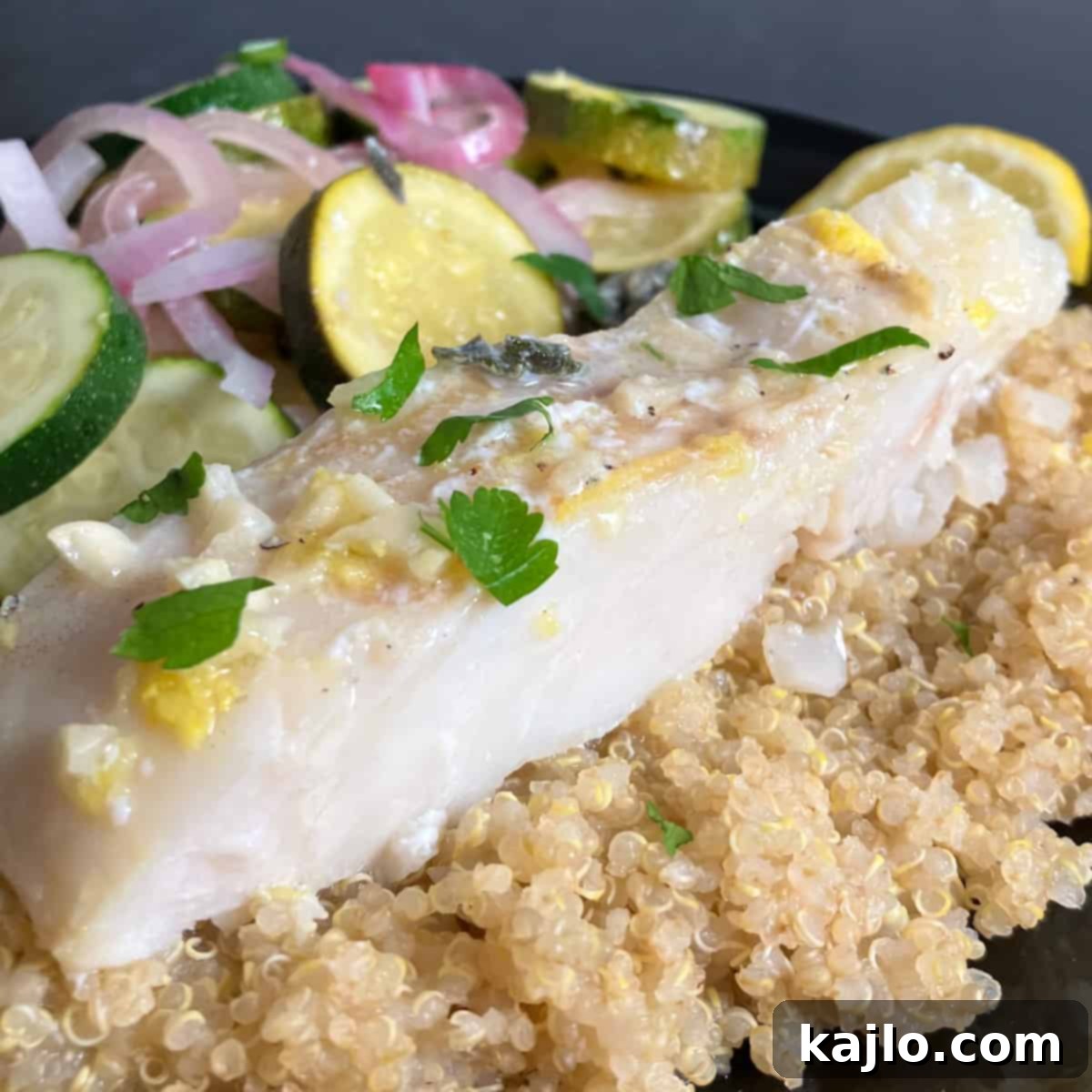
Confirming Doneness: What Temperature is Cod Fully Cooked?
To ensure your cod is perfectly safe and delicious, it should reach a minimum internal temperature of 145°F (63°C). The most reliable way to check for doneness is to insert a meat thermometer into the thickest part of the fish fillet. The fish should also appear opaque throughout and flake easily with a fork. Keep in mind that cooking times can vary based on the exact thickness of your fish fillets and the type of vegetables used. Thicker fillets will require a few extra minutes, while very thin fillets might cook faster. Adjust your cooking time accordingly, always prioritizing the internal temperature for food safety and optimal texture.
Elevate Your Meal: Delicious Side Dishes for Cod in Parchment
The beauty of Cod En Papillote is that it’s a self-contained meal, offering protein and vegetables in one neat package. However, pairing it with thoughtfully chosen side dishes can transform it into a truly satisfying and complete culinary experience. As a dietitian, I often recommend serving fish cooked in parchment with a nutritious whole grain and additional non-starchy vegetables to round out the meal and increase satiety.
Classic pairings include earthy whole grain wild rice or a refreshing tomato-cucumber salad, which offers a lovely contrast to the richness of the lemon-butter sauce. While the packets already contain tender zucchini and sweet red onions, I always encourage adding more fresh veggies to the meal for an extra boost of nutrients and vibrant flavors.
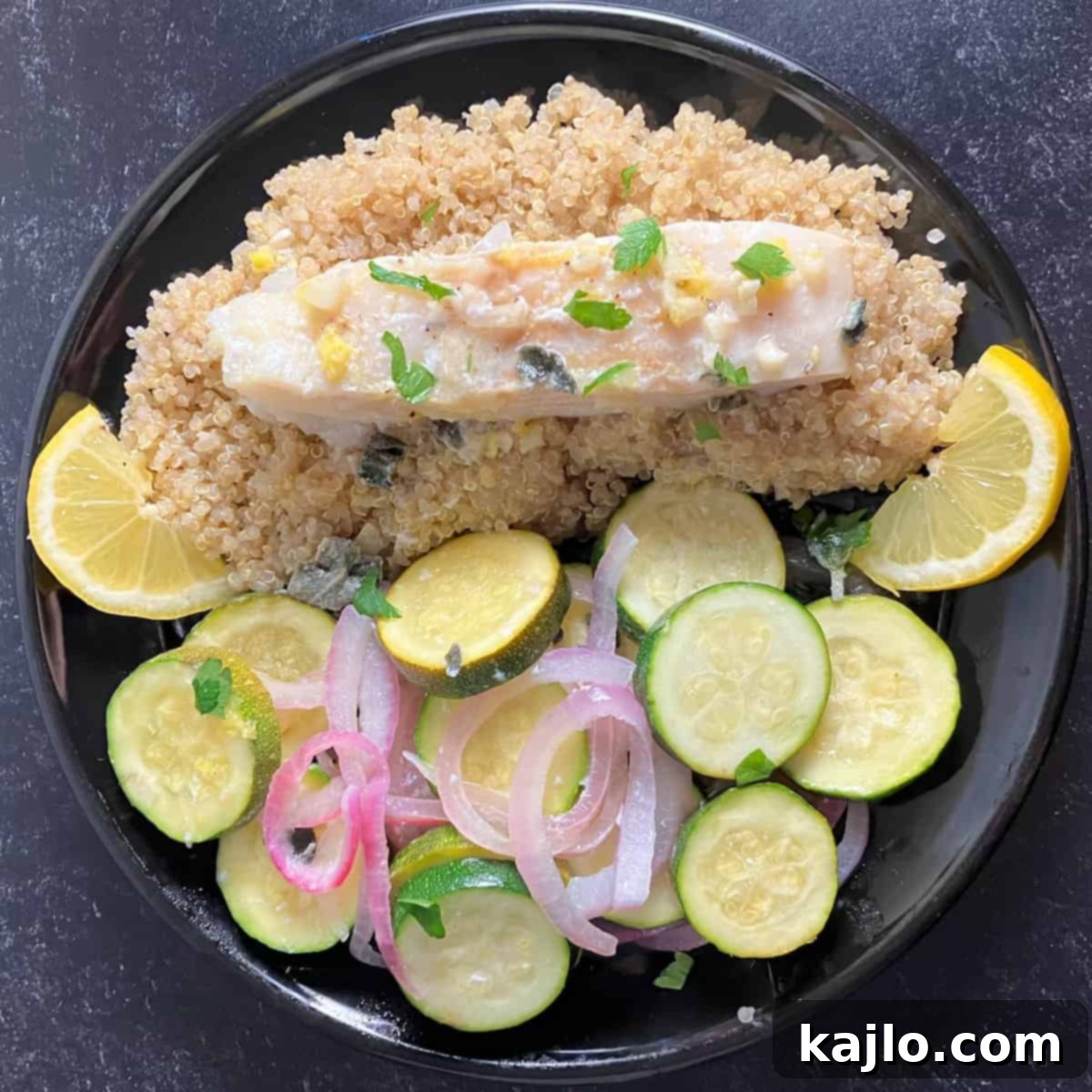
Here are some additional ideas for what to serve alongside your exquisite fish en papillote:
- Crisp Vegan Spinach Salad: A light, vibrant salad adds freshness and a delightful crunch.
- Air Fryer Frozen Vegetables: An excellent option if your oven is busy! Use your air fryer to quickly prepare crispy broccoli or other favorite frozen veggies while your fish cooks.
- Air Fryer Jicama Fries: A unique and healthy alternative to traditional fries, offering a satisfying texture and mild flavor.
For those who enjoy a truly artisanal touch, consider making your own butter to use within the parchment paper packets. My Homemade Amish Butter Recipe is a simple guide to creating fresh, rich butter that will take this dish to an even higher level of indulgence.

Cod En Papillote Recipe (Cod Cooked in Parchment with Vegetables)
By Summer Yule
What is cod en papillote? This elegant cooking method is the secret to preparing fish that is consistently moist, tender, and incredibly flavorful, rather than dry. It’s surprisingly easy and a must-try for any seafood lover!
Prep Time: 7 minutes
Cook Time: 18 minutes
Total Time: 25 minutes
Course: Dinner
Cuisine: American, French
Servings: 3
Calories: 246 kcal per serving
Ingredients
- 1 lb. boneless cod fillets, ¾-inch (1.9 cm) thick (approximately 454 grams; 3 fillets)
- Cooking oil spray of choice
- 1 lb. zucchini, cut into ½-inch (1.27 cm) thick slices (approximately 454 grams)
- 2 tablespoons fresh squeezed lemon juice
- 1 teaspoon lemon zest
- 2 cloves garlic, minced
- Salt and pepper, to taste
- ½ small red onion, very thinly sliced
- 6 leaves fresh sage, finely chopped
- 3 tablespoons butter, cut into 6 pieces
Love this recipe? Please leave a comment below 😊
Instructions
- Preheat your oven to 400°F (200°C).
- Lay out 3 pieces of aluminum foil, each approximately 14-18 inches (35.6-45.7 cm) in length. Top each piece of foil with a matching piece of parchment paper, also 14-18 inches (35.6-45.7 cm) in length.
- Lightly mist the center of each piece of parchment paper with your chosen cooking oil spray.
- Arrange the zucchini slices in a rectangle shape (roughly 3 slices by 4 slices) in the middle of each sheet of parchment paper. If you have any additional zucchini slices, layer them on top of these rectangles. (Note: The number of slices may vary based on the size of your zucchini.)
- Place one cod fillet on top of each zucchini rectangle.
- Evenly pour one-third of the lemon juice over each cod fillet. Then, sprinkle the lemon zest, minced garlic, salt, pepper, finely chopped sage, and thinly sliced red onions on top of the fish (applying them in this order helps layer the flavors).
- Place two pats of butter on top of the food in each packet (i.e., each packet gets one tablespoon of butter total).
- To fold the packets: First, snugly wrap the parchment paper around the food. Bring the top and bottom edges of the parchment together and fold them over several times to create a tight seal. Then, fold and crimp the side edges to fully enclose the contents. Next, secure the parchment by repeating the same folding process with the outer layer of aluminum foil. Ensure both layers are sealed tightly to prevent any steam or sauce from escaping.
- Once each food packet is completely encased in both parchment and foil, place them in a single layer on a large baking sheet, ensuring they are not overcrowded.
- Position the baking sheet with the packets on an oven rack that is one-third of the way down from the top. Steam the cod for 18-20 minutes at 400°F (200°C).
- After the cooking time, carefully remove the baking sheet and unwrap your packets. The cod should be tender and flaky. Use a meat thermometer to verify that the internal temperature of the fish has reached a safe 145°F (63°C). If needed, reseal and cook for a few more minutes until the desired temperature is achieved.
- To serve, carefully transfer the contents of each fish packet, including the delicious lemon-butter sauce, onto individual plates. I highly recommend serving the fish and its flavorful sauce over a bed of cooked whole grains. You can also mix the cooked red onions with the zucchini or arrange them beautifully on top of the fish.
Equipment
- Parchment Paper
- Aluminum Foil
- Baking Sheet
- Kitchen Thermometer
Expert Tips from Dietitian Summer Yule
This is a level 1 recipe (may help support fat loss). White fishes, such as cod, are an excellent source of lean protein. Cod provides a significant amount of protein for very few calories, which can help keep you feeling full and satisfied, making it easier to achieve or maintain weight loss goals.
Additionally, this cod en papillote recipe is packed with zucchini, a non-starchy vegetable. Non-starchy vegetables offer a substantial volume of food with minimal calories, a strategy I frequently use to enjoy large, filling meals while staying within a healthy calorie balance. Incorporating non-starchy vegetables into most of your meals is a fantastic approach if you’re aiming for weight management.
As written, this recipe provides under 300 calories per serving, which typically isn’t a complete meal on its own. To make it a more substantial and balanced meal, I recommend adding ¼-cup of dry (which yields ½-¾ cup cooked) whole grains, contributing an additional 150-200 calories. I also often include more non-starchy veggies or a serving of fruit.
Nutrition information is for one serving of the recipe as prepared.
Nutrition Info Disclaimer
All recipes on this website may or may not be appropriate for you, depending on your medical needs and personal preferences. Consult with a registered dietitian or your physician if you need help determining the dietary pattern that may be best for you.
The nutrition information provided is an estimate and is offered as a courtesy. It may vary depending on the specific brands and ingredients you use. Calorie information on food labels can sometimes be inaccurate, so please don’t obsess over the numbers too much.
“To taste” means to adjust according to your preferences, but always keep food safety rules in mind. Please do not consume undercooked food.
Nutrition Facts (per serving)
- Calories: 246 kcal
- Carbohydrates: 8.4 g
- Protein: 20.4 g
- Fat: 15.1 g
- Saturated Fat: 7 g
- Potassium: 483.2 mg
- Fiber: 1.7 g
- Vitamin A: 14.6 % DV
- Vitamin C: 57.1 % DV
- Calcium: 9.3 % DV
- Iron: 8.5 % DV
Keywords
cod cooked in parchment, cod en papillote, cod in parchment, cod in parchment with vegetables, cod papillote, codfish en papillote, fish en papillote, keto, low-carb, steaming cod in parchment, healthy cod recipe, easy fish dinner
Shop our cookbook! Easy Air Fryer Recipes for One
Burning your air fryer recipes? Here’s how to fix it!
Nutritional Overview: Calories, Net Carbs, and Protein
Understanding the nutritional profile of your meals is essential for healthy eating. One serving of this delicious cod en papillote with veggies provides a balanced and lean nutritional intake. Each serving contains approximately 246 calories, 6.7 grams of net carbohydrates, and a robust 20.4 grams of protein. This nutritional breakdown pertains specifically to one serving of the cod in parchment recipe as described, excluding any additional side dishes you might choose to add to your plate. This makes it an excellent choice for those focusing on lean protein intake and mindful carbohydrate consumption, fitting well into various dietary plans.
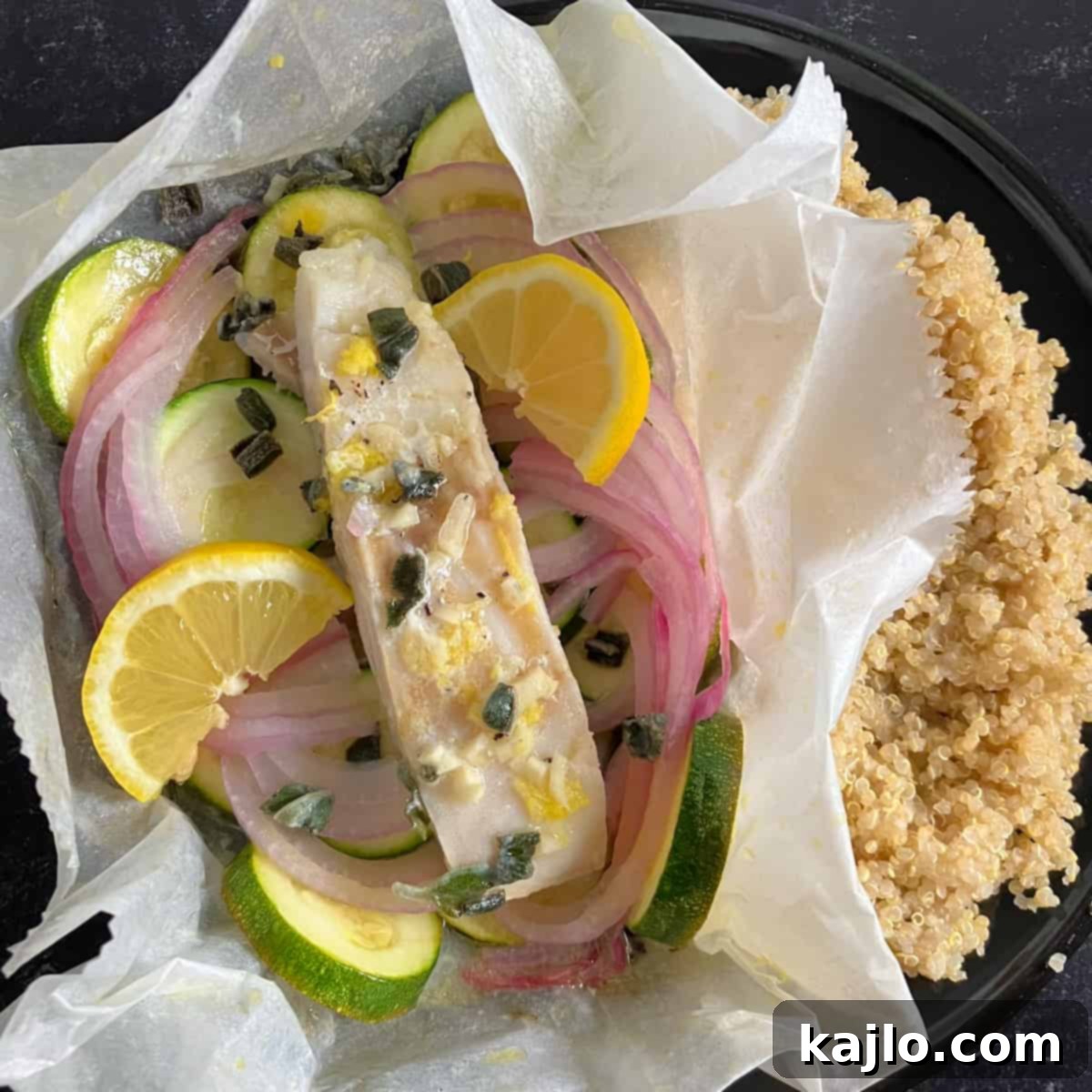
Frequently Asked Questions About Cod En Papillote
Here are answers to some common questions you might have when preparing cod en papillote, offering insights to help you achieve the best results.
Is Parchment Paper the Same as Wax Paper?
Absolutely not! Parchment paper and wax paper are distinct products with different properties and uses. Parchment paper is treated with silicone, making it non-stick and highly heat-resistant, perfect for oven baking and creating our en papillote packets. Wax paper, on the other hand, is coated with a thin layer of wax. While it can be used for food storage or lining countertops, it is NOT heat-resistant. If used in a hot oven, wax paper will melt, contaminate your food, and can even pose a fire hazard. Therefore, it is critical to use only parchment paper for this recipe and any oven-related cooking. I remember a close call when my son first started baking High Calorie Chickpeas on his own. Luckily, he instinctively grabbed the right paper! Always double-check your baking paper before it goes into the oven.
Is it Better to Use Aluminum Foil or Parchment Paper?
Both aluminum foil and parchment paper have their unique strengths in the kitchen. While traditional “en papillote” often implies solely parchment, I find that a combination of both yields the best results for this cod recipe. My preference is for the food to come into direct contact with parchment paper, as it’s non-reactive and won’t impart any metallic taste, making it the ideal inner layer. The aluminum foil, placed on the outside of the parchment, serves multiple crucial functions: it provides structural support, helping to maintain the integrity of the folded parchment packet; it acts as an additional insulating layer, ensuring consistent steaming; and most importantly, it offers a robust barrier that prevents any precious lemon-butter sauce from leaking out into your oven. This dual-layer approach guarantees maximum flavor and a mess-free cooking experience.
Can I Cook Other Fish En Papillote?
Absolutely! The en papillote method is incredibly versatile and works wonderfully with a wide variety of fish. I’ve experimented with several types, and the results are consistently excellent. For instance, I highly recommend trying salmon en papillote; simply swap the cod fillets in this recipe for salmon fillets. The cooking principles remain the same, though you might find the salmon takes a minute or two less or more depending on its fattiness and thickness. The primary consideration when substituting fish is its thickness. This recipe is optimized for fish fillets that are approximately ¾-inch (1.9 cm) thick. If your chosen fish is significantly thicker or thinner, be prepared to adjust the cooking time accordingly to ensure it cooks through without drying out.
Can I Cook Other Vegetables En Papillote?
Yes, you certainly can customize the vegetables to your liking! While zucchini is a fantastic choice due to its quick cooking time and tender texture, feel free to experiment with other non-starchy vegetables. The key is to select vegetables that cook at a similar rate to fish, or to prepare denser vegetables in a way that allows them to cook quickly. Excellent alternatives include other summer squashes, thinly sliced bell peppers (any color), delicate leeks, crisp asparagus spears, slender green beans, or sweet halved grape tomatoes. Incorporating a dollop of pesto can also add another layer of flavor. If you wish to use denser vegetables like potatoes, carrots, or fennel, it’s crucial to slice them very thinly – ideally paper-thin – or even blanch them slightly beforehand. Extending the overall cooking time of the packet significantly to cook tougher vegetables increases the risk of overcooking and drying out your delicate cod. Additionally, don’t shy away from adding other flavorful items like fresh herbs or briny kalamata olives to your fish packets for an extra gourmet touch.
Can You Make Whole Fish in Parchment Paper?
Yes, absolutely! The en papillote method is not limited to fillets; it can also be beautifully adapted for cooking a whole fish. Cooking a whole fish in parchment paper ensures it stays incredibly moist and flavorful, just like fillets, but often makes for a more impressive presentation. The principles remain similar: choose a fish that fits your packet size, stuff it with aromatics and liquids, and seal tightly. For a fantastic example, you might want to try this whole red snapper in parchment paper recipe.
What About Cooking Frozen Fish in Parchment Paper?
While convenient, cooking fish directly from frozen in parchment paper is generally not recommended for optimal results. Frozen fish contains extra moisture that, when trapped within the sealed packet, can lead to a watery sauce and potentially a less flavorful, mushy texture. For the best possible outcome – perfectly tender, flaky fish with a concentrated sauce – I strongly advise thawing frozen fish completely before proceeding with this en papillote recipe. Once thawed, pat the fillets thoroughly dry with paper towels to remove any residual surface moisture before assembling your packets.
How to Make Fish En Papillote: Air Fryer Method
Yes, you can adapt the en papillote method for your air fryer, offering a quicker alternative to oven baking, especially for smaller portions! To cook air fryer fish en papillote, preheat your air fryer to 400°F (200°C). Carefully place a sealed fish packet into the air fryer basket or tray. The cooking time will be significantly shorter than in a conventional oven, typically ranging from 10-13 minutes. It’s often best to cook packets individually to ensure even cooking and sufficient air circulation. Keep in mind that cooking times can vary depending on your specific air fryer model and its wattage. Always use a meat thermometer to confirm that the fish reaches a safe internal temperature of 145°F (63°C) before serving.
Explore More Delicious White Fish Recipes
If you’re a connoisseur of delicate white fish, then you’re in for a treat! Beyond this exquisite cod en papillote, there’s a world of delicious and healthy white fish recipes waiting to be discovered. Here are some of my other favorite seafood creations that I bet you’ll love:
- Effortless Frozen Cod in Air Fryer Recipe: Quick and convenient for those busy weeknights.
- Air Fryer Frozen Tilapia with Garlic Chive Miso Butter: A flavor-packed, easy-to-make dish.
- Steamed Fish in Banana Leaf: A unique and aromatic culinary adventure.
- Crispy Air Fryer Sea Bass: Achieve perfectly cooked sea bass with minimal effort.
- Flaky Air Fryer Halibut: A simple yet elegant way to prepare this premium white fish.
Join our culinary community! Subscribe to receive all of our latest and greatest recipes directly in your inbox, and connect with me on Facebook, Pinterest, Instagram, and YouTube for daily inspiration and cooking tips!
